|
|

This chapter describes how to use ISM. It provides specific information on the following topics:
 |
Note Before starting the ISM user interface, you must define the NetView ISM autotask and initialize ISM. For more information on defining the autotask, see Chapter 3, "Installing ISM," in the CiscoWorks Blue Internetwork Status Monitor Installation Guide. For more information on initializing ISM, see Chapter 5, "Configuring ISM," in the CiscoWorks Blue Internetwork Status Monitor Installation Guide. |
To start the ISM standard NetView 3270 program interface, hereafter called the standard interface, log into NetView, type ism on the command line of the NetView main menu panel, and press Enter.
The Internetwork Status Monitor (ISM) main menu panel(Figure 2-1) is displayed.

This panel shows the date and time ISM was last initialized and the name of the ISM autotask (ISMMGR).
This section describes how to navigate ISM's menus, panels, function keys and command lines. It provides specific information on the following topics:
The ISM main menu panel (Figure 2-1) displays enabled ISM options and applications. To run an option or application, position the cursor on the option or application and press Enter. The selected application panel is displayed.
Use ISM application menus to perform the following functions:
Table 2-1 describes functions in the ISM application menu panels.
| Panel | Function |
|---|---|
Resource Status with Options | Monitors resources |
DSPU Monitoring Operations | (Standard interface only) Monitors routers defined as downstream DSPUs |
TN3270 Status Monitoring Operations | Monitors Cisco TN3270 Servers |
Use the ISM or NetView command line to access ISM applications, both those that appear on the ISM main menu panel, and those that do not appear on ISM menus.
To use the command line interface, position the cursor on the ISM command line prompt, enter an ISM function command, and press Enter. ISM displays the application panel.
For example, you can enter the ism mgr command at the Session Connection History panel (Figure 2-2) command prompt.

The Resource Status panel (Figure 2-3) is displayed:

Use ISM PF keys to navigate panels or run applications. Table 2-2 describes standard ISM PF key functions. (If a panel uses a non-standard PF key function, the function is called out on the panel.)
Key
| Function
|
|---|---|
| |
| |
| |
| |
| |
| |
| |
| |
| |
| |
Use the following standard keys to navigate or update ISM panel options:
You can easily locate options and enter data in ISM input fields. There are two types of fields displayed on ISM panels:
This section describes how to access and view ISM event log messages. It provides information on the following topics:
The ISM Event Log performs the following functions:
To view the Activity Log Browse panel, position the cursor on the LOG line and press Enter. The Activity Log Browse panel (Figure 2-4) is displayed.

To search for ISM events, on the Activity Log Browse panel (Figure 2-4), in the Log field, enter the name of the event log to search:
You can also enter one or more of the following search parameters:
Press Enter to display event records in the Event Log panel that match your search criteria.
The ISM Event Log panel (Figure 2-5) displays current and past event log messages.
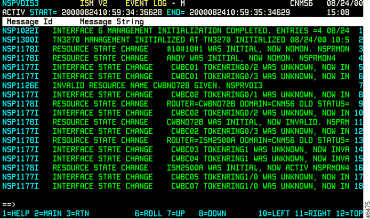
To view help for a message, position the cursor on a message and press PF1.
To return to the Activity Log Browse panel (Figure 2-4) and change the Search Rules, press PF3.
To view earlier event records, press PF7.
To view later (more current) event records, press PF8.
The following subsections describe how to monitor network resources using the following ISM panels:
The ISM Status Summary panel monitors the status of ISM managed resources. You can view the status by resource type and the number of resources in the selected status condition.
This section describes how to use the ISM Status Summary panel to perform the following tasks:
To view the ISM Status Summary panel, on the ISM main menu panel, position the cursor on the SUM line and press Enter. The first panel of the ISM Status Summary (Figure 2-6) is displayed.

To display detailed resource information, position the cursor on a resource type condition and press Enter.
To use the ISM Status Summary panel to display the total number of ISM managed resources, position the cursor on the Total field for resources, then press Enter. ISM lists all ISM managed resources.
If there is a performance (PERF) or alert condition for your selected resource field, only resources in that condition are displayed.
To use the ISM Status Summary panel to view resources categorized by group, enter the group name in the Group field, then press Enter. ISM displays resources for that group. Figure 2-7 shows a sample summary screen for group ALL.
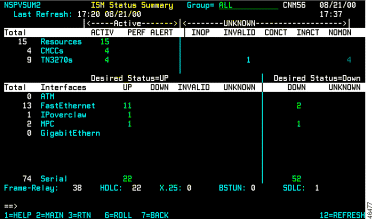
If your operator's profile is authorized for resource group filters, you can view only the group names within that profile. See the "Enabling Monitoring Options for Multiple Routers" section for more information.
To monitor resources, in the ISM main menu panel (Figure 2-1) position the cursor on the MGR line and press Enter. The Resource Status panel (Figure 2-3) is displayed, showing the status of all resources managed by ISM.
The Resource Status panel provides the following features:
For details about monitoring resources, see "Monitoring ISM Resources."
The Resource Status with Options panel offers the following features:
To view the Resource Status with Options panel, select a resource on the Resource Status panel (Figure 2-3), then press Enter. The Resource Status with Options panel (Figure 2-8) is displayed.

To diagnose a resource condition from the Resource Status with Options panel, press PF5. ISM displays the appropriate diagnostic panel for the resource condition, such as NetView's NPDA for troubleshooting hardware problems.
To run one or more resource menu options, type a menu option number or letter in the Enter Option field (or position the cursor on the desired option), then press Enter.
The options displayed depend on the resource type and how it is managed. Available options are displayed in black-on-white. Unavailable options are displayed in blue.
You can switch between ISM and the NetView console from any panel in ISM. From NetView, you can browse the NetView log and run NetView commands and then return to ISM. To go to the NetView console from ISM, press PF6.
To return to ISM from NetView, press PF6 again.
This section describes how to use the ISM Web interface, and provides specific information on the following topics:
 |
Note The ISM Web interface offers many of the same features as the standard interface. However, the Web panels do not support the administrative functions of the standard interface. |
To start ISM in a Web browser, complete the following steps:
Step 2 From your Web browser's location line, enter the IP address and port number where NetView is running (for example, http://11.12.23.10:4800). The Tivoli NetView for OS/390 page (Figure 2-9) is displayed.

Step 3 Enter ism in the Command field and and click Submit. The Username and Password Required dialog box (Figure 2-10) is displayed.
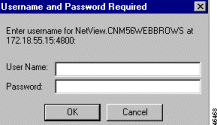
Step 4 Enter your user name and password and click OK. The ISM main menu page (Figure 2-11) is displayed.

Step 5 On the left side of the main menu page, select an ISM option, then click Submit.
The NetView system administrator has the following options:
Figure 2-12 shows the output of the NetView dis command.

The ISM Activity Log records ISM events. When ISM resources change status, or you update their definitions, the ISM activity log records the event. It maintains both primary and secondary logs. When the active log is full, a secondary log automatically becomes active.
You can view the contents of the active or inactive logs, and indicate a date and time range to view events. Once you open the log, you can change the review date and time range.
To view the ISM Activity Log, select the Activity Log option on the ISM main menu, then click Submit to display the browse menu for the active ISM log (Figure 2-13).
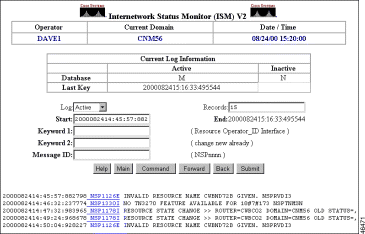
To view events in the inactive log, click the Log field, select Inactive, and click Submit. The browse menu for the inactive ISM log (Figure 2-14) is displayed.
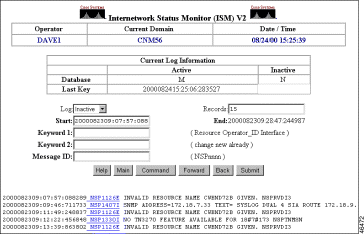
To display events for a selected date or time range, perform one of the following tasks on the active ISM log (Figure 2-13) or inactive ISM log (Figure 2-14) and click Submit:
![]()
![]()
![]()
![]()
![]()
![]()
![]()
![]()
Posted: Sat Oct 7 16:33:41 PDT 2000
Copyright 1989-2000©Cisco Systems Inc.